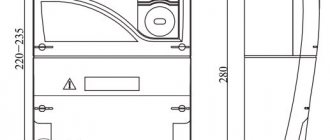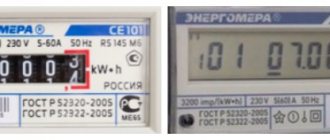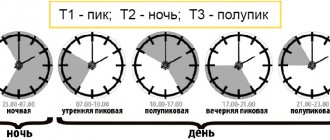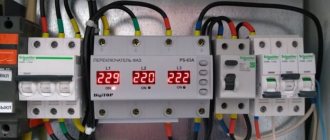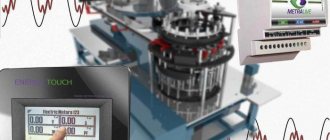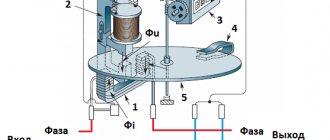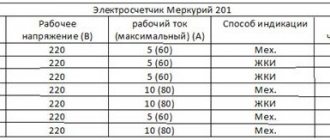The Energomer CE102 electricity meter is a single-phase, multi-tariff device for measuring the used active component of electricity, connected to two-wire AC networks. The device can be used at any individual facilities for commercial settlement of consumers with resource suppliers.
Type of meter – Energomera CE102
Design and principle of operation
The device consists of the following parts, enclosed in a housing with a casing and a terminal compartment cover:
- current sensor;
- microcontroller;
- offline memory;
- built-in clock;
- test output device;
- interface outputs;
- liquid crystal display.
Energy meter CE102 R5
Energy meter CE102 S6
The product can be additionally equipped with protective elements and devices for connection to a centralized control system, depending on the design.
The signals of the incoming electric current are perceived by the measuring module, converted into pulses and, after mathematical processing of the data, displayed on a liquid crystal display. In parallel, the information is recorded on an autonomous memory board and transmitted to a centralized system (for suitably equipped versions).
We take readings from the Energomer SE-102 meter
The Energomer CE-102 electricity meter is a single-phase multi-tariff electricity meter that allows you to take readings at day/night tariffs.
All information is displayed on the meter's electronic display. There are several varieties of Energy Meters CE-102 and they differ in the types of housings, if you look through the eyes of an ordinary ordinary user who has this meter installed in his house or apartment. The housing options are: S6, S7, R5 and R8. Numerical variations of counter models 145, 245, 148, 248.
Viewing display modes can be done either automatically or manually.
- In automatic mode, the data on the display is displayed sequentially and cyclically with a short interval.
- In manual mode, you need to use the control button to select the necessary information. Depending on the model, there are FRAME buttons or an optical view button [PRSM] to switch modes between indicators. For convenience and quick search, all information on the Energomer CE-102 meter was divided into groups. Each group has its own indicators.
Specifications
| Characteristics | Magnitude |
| Accuracy class | 1 |
| Input range: | |
| current, A voltage, V power factor | 0.05 Ib - Imax 0.75 Unom - 1.15 Unom 0.8 cap. — 1.0 — 0.5 ind. |
| Base current, A | 5 or 10 |
| Maximum current, A | 60, 80 or 100 |
| Rated voltage, V | 230 |
| Ambient operating temperature range, °C | -40… +70 |
| Range of meter constant values, imp/(kWh) | from 800 to 3200 |
| Operating frequency range, Hz | 50±2.5 or 60±3 |
| Starting current (sensitivity), mA: | |
| for meters with a base current of 5 A for meters with a base current of 10 A | 10 20 |
| Total power consumed by the current circuit (except for version “Q”), at base current, V*A, no more | 0,1 |
| Total power consumed by a current circuit with a built-in relay in the current circuit (for version “Q”), at base current, V*A, no more | 1 |
| Total (active) power consumed by the voltage circuit (excluding communication modules), V*A (W) | 9 (0,8) |
| Duration of information storage when power is turned off, years | 30 |
| Duration of time and calendar recording with power off, years, not less | 10 |
| Number of tariffs: | |
| for standard version for "Z" version | 4 8 |
| Weight, kg, no more | 1,0 |
| Mounting method | Rail TN35, screws |
| Overall dimensions, mm: | |
| for R5 for S7 for R5.1 | 110×89×72.5 200×122×73 105×90×60,5 |
| Average time to failure, hour | 220000 |
| Service life, years | at least 30 |
| Calibration interval, years | 16 |
| Price, increased rub. | from 1400 |
Dimensions of electricity meters – Energomer CE102 S6
Dimensions of electricity meters – Energomer CE102 R5
Device warranty
The manufacturer guarantees that the product is manufactured in accordance with the technical specifications if the recommendations in the operating instructions for the device are followed. Free repair or replacement if a manufacturing defect is detected is possible until 7 years have passed from the date of release of the product (including storage and operation).
Devices damaged during transportation, installation or operation, or with broken factory seals are not subject to warranty service.
Advantages of the device
The device is characterized by the following advantages:
- multifunctionality in operation, with the presence of a remote access function;
- long warranty period and calibration interval with long service life;
- reliable protection against third-party influence for the purpose of data falsification;
- the presence of built-in memory with the ability to access accounting information for the past period;
- modern and convenient body design;
- high measurement accuracy;
- ease of taking readings.
Methods for transmitting readings
Today, there are several ways to transfer readings to a service organization:
Based on this, it is no more difficult to obtain data from modern meters than from older types of devices. In addition, this electricity meter allows you to significantly reduce fees, thanks to several tariffs.
Some “craftsmen” make the electric meter spin in the opposite direction. Saving money. But there is a real and legal way to save money using the same meter. Recently, new houses are equipped with multi-tariff electricity meters even at the construction stage. One of the tasks of such electricity meters is to save residents’ financial costs. Statistics for Moscow showed that owners of multi-tariff electricity meters save over 25% of the previous amount of paid bills. Many residents of old houses would also like to install new meters, but they are afraid that they will not be able to take readings from such devices. Just the sight of an electronic display scares them. Others have gotten used to it and call the new device “day-night counter.” We are going to tell you how to take readings from the electricity meter day and night.
Before purchasing a multi-tariff electricity meter, you need to find out from the housing and communal services organization how many zones the day in the local power grid is divided into. The day can be divided into 2 or 3 zones. When divided into 2 zones, there is a T1 zone (day) and a T2 zone (night). When divided into 3 zones, there are zone T2 (night), zone T1 (peak), zone T3 (half peak). Each zone has a separate tariff. Also, tariffs differ depending on the presence of a gas or electric stove. In the same housing and communal services organization you can find out all the tariffs. There, be sure to find out the payment codes for each zone. They must be included in the receipt.
According to the information received, you need to purchase a three-tariff or two-tariff meter. Of course, you should never connect the electric meter yourself. To do this you will have to invite a specialist. And he should be asked to configure the device not in automatic mode, but in manual mode. The fact is that if the counter operates in automatic mode, the numbers on the display will change every 30 seconds. Older people may not have time to write them down on paper. It may seem that a two-tariff meter is more convenient - there are fewer numbers. But there is no need to be afraid of numbers. Everything is very simple.
When the meter is operating in manual mode, the letter T with a number from 1 to 3 will be displayed on the display. This number will correspond to the time of day when the meter readings are taken (see point 2). The reading should be recorded. Then press the “enter” button, the number will change, for example, it was T2, it will become T3. Record the reading again. Press the button again, the word Amount or the corresponding icon will appear. Record the reading. Press the button again, T1 will appear. Record the reading. There will be no other signs, only T1, T2, T3 and Sum. The cost of electricity consumption for each zone is obtained by multiplying the zone tariff by the number of kWh in this zone. The total amount is obtained by adding the three zone costs. All that remains is to fill out a receipt for electricity, take it to the savings bank and pay. And move on with your life, knowing now when to turn on the washing machine or dishwasher.
The emergence of modern two and three tariff electronic metering devices is no coincidence.
Increasing loads during peak hours have a negative impact on power grids, and energy companies are interested in a more even distribution of power consumption throughout the day.
Consumers tend to save money, so a discounted payment system at certain hours comes in handy.
If you have already purchased such a device or are just thinking about buying it, you need to figure out how it works and how to take readings from a two-tariff electric meter.
The two-tariff plan involves dividing the day into “Day” and “Night” segments:
- Daytime period 7:00 – 23:00 (in some places until 22:00).
- Night period 23:00 – 7:00.
If you compare the cost of a kilowatt with a single-tariff plan, then at night it will cost significantly less, but you also need to take into account the fact that daytime kW costs more.
The difference between a single-rate tariff and a daily two-rate tariff is the first thing you need to pay attention to when deciding whether to switch to it or not.
In some regions the difference is a few kopecks and is practically not felt.
In others, 25 - 55 kopecks and may not be profitable for most consumers.
The transition to differentiated energy metering is beneficial for those who work a lot and are not at home during the day, and in cases where the apartment has powerful energy-intensive equipment, the inclusion of which can be scheduled at night.
These can be heaters and electric heating boilers, boilers, dishwashers and washing machines and other programmable appliances.
There are also plans that take into account peak energy consumption times. These are several morning hours when most businesses start working (7:00 – 10:00), and evening hours when people return home and turn on household appliances (17:00 – 21:00).
In this case:
- The night tariff is the same as in the two-tariff option.
- The daily peak is the most expensive.
- Daytime half-peak costs the same as a single-rate plan.
The meters are produced programmed for modes. You can read about what exactly these plans are in the instructions. It will indicate how many modes there are and at what hours. And also, does the payment system change on weekends (in some plans, on Saturday and Sunday, the grace period starts at 15:00).
Meter readings
Also, a certain number of days per year (usually 16 - 21) can be arbitrarily set as “red” holidays, on which a reduced tariff will apply. It is important for such devices that the date and time are set correctly on them.
In any case, to truly save on energy in this way will require planning. There is a positive experience when a large-volume water boiler was installed in comfortable houses, which was heated at night at a minimum rate. During the day, this water was consumed, and the central hot water supply was not used, which made it possible to save money.
To objectively calculate the benefits, you need to add the cost of the two-tariff meter itself and its installation.
By calculating the monthly benefit and dividing the cost of the equipment by it, you can find out the payback period of the device.
Types of counter
There are 2 main types of devices available: 102 and 102M (modernized).
Model 102 is produced in two housing options: R5.1, and S7.
The following modifications of meters are made in R5.1 housings:
- 145J – model of accuracy class 1, with a rated voltage of 230 V, base and limit current values of 5 and 60 A, respectively, equipped with an optical port, mounted on a DIN rail;
- 145JAN – additionally equipped with an RS485 interface with external power supply.
Versions of meters in S7 housings:
- 145JAKSVZ - modification with current and voltage characteristics, similar to the first model in the previous list, except for an optical port, equipped with an RS485 interface, telemetry output, AC alarm relay, electronic seal on the terminal compartment cover and with an expanded set of parameters;
- 145JAKVZ – differs from the previous model in the absence of an alarm relay;
- 145JPKQVZPLC1111 – in addition to the optical port, telemetric output, electronic seal on the terminal compartment cover and an expanded set of parameters, it is additionally equipped with a PLC device and a communication module;
- 145JPKSVZPLC1111 – similar to the previous version, but instead of a load relay, an alternating current alarm relay is installed.
Modifications of 102M devices in R5 housings:
- 145A – a product with similar current and voltage parameters, equipped with an RS485 interface;
- 145J – corresponds in terms of characteristics and equipment to the first model in the previous list;
- 148A - differs from the first modification in the list in current parameters - 10 and 100 A;
- 148J – version with an opto port, with similar current and voltage characteristics.
Modifications of the same model in the S7 case:
- 145AV – version of the first accuracy class, voltage – 230 V, base (limit) current – 5 (60) A, equipped with an RS485 interface and an electronic seal for the terminal compartment;
- 145JV – characterized by the presence of an optical port instead of an RS485 interface;
- 148AV, 148JV are analogues of previous models, they differ in current characteristics - 10 and 100 A.
Explanation of meter markings – Energomer CE102
How to take readings from the electricity meter Energomer CE 101, CE 102, TsE6803V?
For electronic devices of Energomer models, the procedure for obtaining readings is quite simple and does not require any pressing of control keys; in fact, on some modifications they are absent altogether.
Front panel of meter CE 102
Every 10-15 seconds, the display cyclically displays the data of time zones from T1-T2 or T1-T3 (depending on the modification of the device) and their total value. In this case, the name of the tariff (T1-T3 and T - the total amount) and, in fact, the readings in the form of a number with two decimal places are displayed at the top of the screen.
Front panel of meter TsE6803V housing type P32 (for DIN rail)
Taking readings
To take readings, the whole number is taken into account, without taking into account fractional parts (to the right of the point on the display).
Purpose of symbols on the indicator
Data is collected in the following order:
- The current value is written on the screen according to the first tariff.
- The number recorded last month is subtracted from the resulting number.
- The difference is multiplied by the price amount.
- Operations are repeated similarly for all other configured tariffs.
- The results obtained are summarized.
Switching between tariffs is done manually (by pressing a button) or automatically.
Indication modes for CE 102 meters in S6 and R5 housings
To take readings on these models, press the mechanical or optical button with long presses (hold for more than 3 seconds) and view the information.
The first branch of values shows auxiliary parameters such as time, date, etc.
Read
Counter SO-EU10 - technical characteristics
Group 2 - general readings for all tariffs To go to the next (2nd) navigation branch, press the [PRSM] button; the first value is the amount of current expenses (indicated by the letter T) according to the current tariffs (without the clock and hammer and screwdriver icons). By briefly pressing the button, you can also view the amount at the end of last month (1T), the day before last (2T) and finally 13 months ago (13T).
If we pay according to a single tariff plan: To take readings, we need the first value with the T icon write it down , if you pay according to one tariff, then the mission is completed, the readings are recorded, in order to calculate the amount for payment, we multiply the recorded number by the rate for 1 kilowatt/hour.
If we pay according to a two-tariff plan: Group 3 - information on tariff 1 (day) If we pay according to day/night tariffs, then from the second group with a long press on the [PRSM] or [FRAME] button we go to the next (3) branch of indicators - this is indicators for 1 tariff.
We see the first indicator with the T1 and kWh - this is the current total value of electricity consumption at tariff 1. We write down this value . Then, with short presses of the button, just like in the previous group, we can view the following values at tariff 1:
- Expenses at the end of last month (1T1 icon)
- Consumption at the end of the month before last (2T1 icon)
- Consumption at the end of 13 months ago (icon 13T1).
Group 4 - information on tariff 2 (night) Let's move on to group of indicators (4) - these are consumption indicators for tariff 2.
The first value is the amount of total consumption at tariff 2 (T2 icon). Write down the value . As in the previous group, by short pressing the [PRSM] or [FRAME] button we can view the expenses for tariff 2
- at the end of last month (1T2)
- at the end of the month before last (2T2 icon)
- at the end of 13 months ago (icon 13T2).
Connecting the meter
The product is secured using screws or a DIN rail, depending on the design of the housing in the specific version of the meter. Qualified electricians are allowed to carry out work on connecting the device. The diagram is indicated in the device manual or on the terminal compartment cover.
When performing work, the current supply is turned off and turned on after connecting the contacts. Then the device is adjusted and sealed. Commissioning is recorded by an entry in the form by a representative of the organization that installed the meter.
Connecting the energy meter Energomer CE102
Connecting the device is no different from installing a conventional single-phase electric meter:
The main difference and difference lies in the additional options of the device. Their connections must be checked with the diagrams specified in the device instructions.
Electrical work to install the product must be carried out in accordance with safety regulations. Be sure to turn off the power!
The energy meter Energomera CE102 is still produced. The cost, depending on the design, ranges from 1500 to 2400 rubles.
